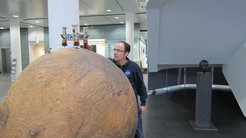NASA Award for MPS Engineer
As a member of the InSight Instrument Site Selection Team, Dr. Marco Bierwirth selected the deployment site for the seismometer SEIS on the surface of Mars.
The U.S. space agency NASA has honored the 49-member group of experts who selected the site for the scientific instruments carried by the InSight Mars probe in the days following its landing with the NASA Group Achievement Award. Among the honorees is Dr.-Ing. Marco Bierwirth of the Max Planck Institute for Solar System Research (MPS) in Göttingen. Under his leadership, the MPS had previously developed and built hardware components for InSight's seismometer SEIS. Bierwirth experienced the landing and commissioning of InSight in the United States at the control center of NASA's Jet Propulsion Laboratory (JPL). As a member of the Insight Instrument Site Selection Group, he examined where SEIS would find optimal working conditions in the immediate vicinity of the landing probe. SEIS has been recording quakes on Mars for nearly two years. It is the first seismometer to provide meaningful seismic data from the red planet.

On Nov. 26, 2018, NASA's Insight spacecraft landed on Mars with the goal of determining geophysical properties of our neighboring planet, such as internal structure and heat flow from the interior. Two of the scientific instruments that traveled aboard to the red planet require direct contact with the Martian surface for their measurements: the seismometer SEIS, provided under the leadership of the French space agency CNES, and the HP3 heat flux probe from the German Aerospace Center (DLR). InSight's robotic arm placed both instruments in the Martian sand a few days after landing; cables keep them connected to the lander.
This was preceded by a sophisticated selection process. "For the instruments to function optimally, the optimal choice where they will be deployed is crucial," Bierwirth explains. Determining this was the task of the InSight Instrument Site Selection Group from the fourth to the fourteenth day of the mission (calculated in Martian days). The group, consisting of representatives of the instrument teams, NASA engineers, and Mars geologists, had already drawn up a catalog of 25 conditions that the instruments’ "workplace" should fulfill. These now had to be verified using the first images provided by InSight's cameras.
"When InSight sent the first images immediately after landing, it became clear that the probe had landed in a shallow, sandy depression. That was a great relief," Bierwirth recalls. "Just a few meters away, you can see much more rock at the edge of the depression. Such an environment would have made deploying the instruments much more difficult," he adds.
In addition to the distribution of boulders and small stones, surface slope, and texture, several technical criteria also played a role in selecting the most suitable location. Among other things, MPS engineer Bierwirth focused on SEIS’s protective shield. It was to be slipped over the sensitive instrument after SEIS was deployed to protect it from wind, extreme temperatures, and other environmental influences. "Optimally, SEIS and the protective shield must be at the same height. This cannot be achieved on all topographies," Bierwirth says.
SEIS has long since proven that the labor-intensive ten (Mars) days have paid off. Since February 2019, the instrument has been measuring all quakes jolting our neighboring planet and has thus become the first "earthquake observatory" on Mars.
Dr. Marco Bierwirth studied electrical engineering and materials engineering at Otto von Guericke University Magdeburg. He joined the MPS in 2008, where he has since been working on the development of hardware for a Mars seismometer. The MPS contribution to the InSight mission is the SEIS leveling mechanism. It ensures that the instrument automatically aligns itself exactly horizontally after deployment on the Martian surface. This is a crucial prerequisite for high-precision seismic measurements.
With the Group Achievement Award, NASA annually recognizes teams that have made an outstanding contribution to achieving NASA's goals.












